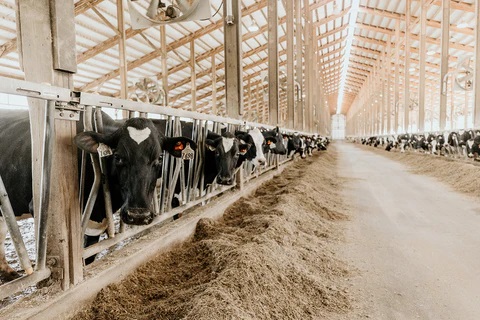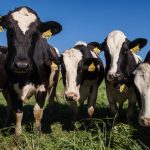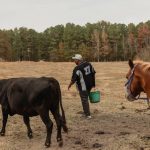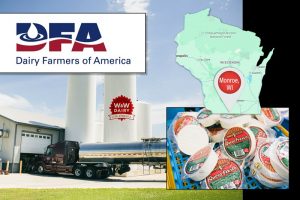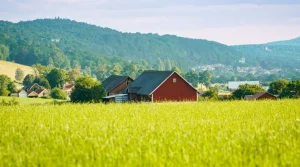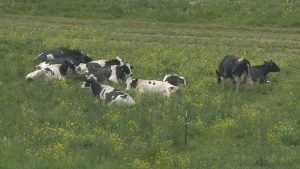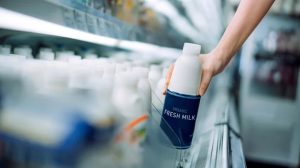
Two giant dairies proposed for eastern North Dakota would more than quadruple the state’s current dairy cow population, according to North Dakota Agriculture Commissioner Doug Goehring.
Riverview, LLP, based out of Morris, Minnesota, is seeking permitting to build a 12,500-head dairy in Richland County, North Dakota, near Wahpeton, and a 25,000-head dairy in Traill County near Hillsboro.
Currently, North Dakota has 24 dairy farms in the state, with fewer than 10,000 milk cows.
“North Dakota has around 8900 dairy cows,” Goehring said. “The dairy industry in the state has really imploded.”
Goehring said that labor has been an issue with dairies shutting down.
“Farms don’t have as many family members any more. It used to be when you had kids, you had labor, but often, as soon as they graduated from high school, the milk cows went to town. My wife grew up at Zeeland, North Dakota, and when she graduated, her dad said the cows were going.”
Labor is one side of it, processing is another, Goehring said.
“We’re talking about the chicken and the egg. If there are not enough dairies to supply the processing facilities, then the processors can’t make it, so they shut down. We lost a processor in Bismarck and that hurt. A few dairies followed.”
The cheese plant closing at Pollock, South Dakota, on August 30, is “the death wish,” Goehring said. “There are only a few operations that are probably going to survive.”
Now all milk in the state has to be trucked to Fargo.
“The dairy industry has to operate at an economy of scale,” Goehring said.
Their margins are probably not much different than anyone else in the business, but through sheer size they can spread some cost out. They need to match what labor they can get and they are building in increments to consolidate milk production and coordinate how many tankers are needed, where the milk is processed and how much that processing facility can handle. For every 100,000 cows you have, you can justify building a new processing plant.”
Commissioner Goehring said that economists predict that the global dairy market demand for cheese and dry milk will grow exponentially.
“Europe and the U.S. are very good at cheese consumption, but the rest of the world is just learning about cheese, and they are loving it,” he said. “Developing countries need calories and they need protein; dairy products can supply that.”
Goehring said that the department of agriculture has been working with Riverview to figure out the logistics of developing dairies of this scale.
“I have asked a lot of questions over the last five years,” he said. “The footprint needed is huge. Can we even support dairies this size if they come in? These operations are no longer trying to ‘do it all’ themselves. They are experts at caring for and milking cows, and they want to partner with the community for feed production and their manure management plan.”
Farmers in the communities where the new dairies are proposed love the idea of marketing their grain directly to Riverview and having manure available to spread for fertilizer, Goehring said.
“They are willing participants. They will not be at the mercy of the grain market any more. Selling to neighbors with very little transportation cost, while they may not always be at the top of the market, will give them more stability in marketing and make it so much better for them. People having these conversations are excited.”
With tens of thousands of dairy cows in one facility, biosecurity will be more important than ever, but Goehring said that the absence of other animal agriculture operations in eastern North Dakota make that area ideal for the proposed dairies.
“When it comes to biosecurity, one issue is ‘what’s the closest or adjacent operation to you?’” he said. “Biosecurity measures are certainly going to have to be adhered to. Other places that have large numbers of cows have shown that they can keep operating through the Highly Pathogenic Avian Influenza outbreak.”
Goehring said agriculture practices in the U.S. involve choice for every farmer and rancher.
“Let’s embrace that choice and get rid of the infighting,” he said. “Our adversaries are not in agriculture.”
Riverview, LLP
Riverview, LLP, operates as a diversified agribusiness involved in dairy, beef, and crop production, according to spokesperson Martha Koehl.
“Riverview began as a crop and beef farm in Morris, MN in 1939,” she said “In 1995, we entered the dairy industry and built our first dairy. Over the years, we have become an integrated agricultural operation that includes dairy, beef, and crop production. Today, our company is predominantly owned by Riverview employees with the mission to provide a culture of opportunity for passionate people and innovative ideas.”
This type of project begins with site viability and interest from local farmers, Koehl said.
“If found viable, it will result in a project launch where stakeholders are contacted and public engagement increases. From there, our team continues local outreach and completes a state application that is reviewed by North Dakota NEQ. If approved, construction can begin and typically takes 18-24 months until the cows arrive.”
Riverview is currently in the permitting process for both projects and does not have a set opening date for either project at this time.
Koehl said biosecurity issues will be addressed in the permitting process.
“CAFO permits in North Dakota are regulated by the ND DEQ, whose role is to ensure a permit holder has taken the proper steps in order to operate without harm to the environment, animals, or humans.”
Farmers involved in crop production benefit from the opportunity to grow alfalfa, wheat, and corn silage to feed the cows and in turn purchase manure from the dairies as a fertilizer source.
“Our model is that we would purchase 100% of the feed from and sell 100% of the manure to local farmers,” Koehl said. “Additionally, we employ custom harvesting and manure crews that are often made up of members of the local farming community. We have a long history of operating in this manner in western Minnesota and eastern South Dakota.”
Where the milk will be processed will be determined in conjunction with the permitting process and regional processing growth and capacity.
A project like this has the potential to play a significant role in economic impact in the area, Koehl said.
“This can include monetary measures such as the annual payroll, repairs and utilities, and also through job opportunities for full-time employment, as well as seasonal work and internship opportunities. With increased employment comes an increased customer base for local businesses and young families in the school district. We are passionate about agricultural education and open our doors for dairy tours, host a scholarship program, and partner with local 4H and FFA chapters. Our goal is to be a good neighbor in the communities in which we live and work.”

Pollock Cheese Plant Closes
Kansas State University Professor Emeritus Ken Odde grew up milking cows on his parents’ farm near Pollock, South Dakota. Dairy Farmers of America (DFA) recently announced that the milk processing plant in Pollock will close August 30, because the business is no longer “economically viable.”
“My father was one of founders of the Pollock cheese plant, which opened in 1960. A group of local people made the investment to build the facility and hired an individual who knew about making cheese. That was before we had bulk milk; people were selling milk in 10 gallon cans. Almost everyone milked cows at the time; that was the cash cow for the farmer because you got a check every couple of weeks. You only got a grain check once a year, and cattle checks maybe twice a year.”
It’s hard to blame people for not wanting to spend the time required for milking cows, Odde said.
“My parents sold the milk cows the day their youngest child went off to college in 1971. My mother grew up milking by hand; her family milked 8-10 cows morning and evening. She and I used to milk a lot together. If we had a fresh cow to milk out, she could milk three times as fast as I could. She was good at it. Our parents’ generation and the ones before worked their tails off.”

Four part time and 33 full time employees will lose their jobs when the plant closes, Odde said. He is working with others to try to find a buyer for the building that will bring another business to town for an employment opportunity.
“There is a much broader effect when the top employer in a community shuts down. It has a regional impact. The employees were not just residents of Pollock, quite a few people drove in some distance from farms and neighboring communities. It’s so critical to a little town and to the other businesses in town.”
The dairy industry in South Dakota has grown by leaps and bounds in recent years, but Pollock was too far from the expansion, happening mainly along the I-29 corridor, to take advantage of the growth, Odde said.
“In part, the closure is due to supply and demand issues in the dairy industry. We do understand that the milk supply in our region is dwindling. People have been trucking milk from further and further distances all along, which makes them a little less competitive. It’s difficult.”
Another cheese factory in Hoven, South Dakota, about 70 miles from Pollock, closed in January of 2024.
“They told us the economics just don’t work,” Odde said.
Although he’s “semi-retired,” Odde helps his son John who manages the family’s beef cattle business. Odde is aware of the planned Riverview dairies in eastern North Dakota.
“They also have a big one going up in DeSmet, South Dakota,” he said. “Riverview has been a player in the beef industry as well, and they are leaders in the Beef on Dairy movement. Since most replacement heifers are produced with sexed semen now, that makes more cows available for breeding to beef bulls. Riverview also owns the feedlot at McLaughlin, South Dakota.”
Now Odde is using his economic development background to try to fill the gap when the DFA plant closes.
“We’re trying to do the best we can to bring some kind of viable business in that will be good for this community,” he said.

Hoff Dairy
Harvey Hoff, Richardton, North Dakota, milked cows most of his life. His parents milked cows, and Hoff and his wife Janal took over the dairy when they got married in 1980. All of their cows were born and raised on the farm.
“We milked together 42 years,” Hoff said.
Hoffs sold their cows and equipment two years ago.
“It’s sad, it really is,” he said. “We wanted to milk another five years or so, but I could see the writing on the wall and the time was right to sell. I didn’t want to sell when they called and said ‘in 2 weeks you won’t have a milk truck anymore.’”
Hoff said they were fortunate to find a good home for their cows.
“When they came to pick them up, Janal said, ‘I have one condition; I have rights to come visit my cows whenever I want.’ He started laughing, and I said, ‘She’s dead serious.’”
Hoffs installed the first robotic milking system in North Dakota in their barn in 2012.
“It wasn’t so much the technology, but the ability to give us some free time,” Hoff said. “That’s what I liked; it was geared toward family farms.”
Now Hoff says the small family dairy farm is a thing of the past. Recently a young farmer from the Jamestown area reached out to Hoff about getting set up to milk 30-40 cows.
“It was a family thing, his mom and dad were going to help him get started. He reached out to DFA about buying milk, and they wouldn’t buy it from an operation that small. I understand why it’s happening, but I don’t agree with it,” Hoff said. “I can say that now that we’re no longer milking.”
Hoff said a big reason the dairy industry is moving more toward giant operations, such as the dairies proposed by Riverview for eastern North Dakota, and away from small family farms, is the loss of markets for milk.
“When we started milking in 1980 you could throw a rock in any direction and hit a processing plant: cheese, butter, milk, ice cream, they did it all.”
Today the Cass-Clay plant at Fargo is the only milk processing plant in the state. A DFA plant at Pollock, South Dakota, where many North Dakota dairies sold milk, is scheduled to close August 30. To the west, Hoff said, the nearest plant is west of Billings, Montana.
“When we quit, we were down to two, and it went to one after we quit. There’s no competition, no reason for them to give farmers a good price. It’s not feasible to truck milk from the west side of the state to Fargo, but a couple farms out here are going to try it.”
Hoff said Riverview runs good dairies and they have a good product, but small farms can’t compete.
“It’s just not possible,” he said. “The cheese plant would rather deal with one dairy than 20, although small dairies put out a very good product, and we put more money into our communities than a large dairy will.”
Hoff said there were 1800 dairy farms in North Dakota in 1980.
“Now we’re down to 24 and it’s going to go lower. As expenses went up, the milk price hasn’t. I was still getting the same price for milk as my mom and dad did in the 60s.”
While Hoff doesn’t have anything against Riverview building the big dairies, he doesn’t like seeing more and more family farms going out of business.
“They run good dairies and have a good product, but I can’t compete with that. It’s just not possible. When they add another 30,000 cows, how many small farms do they take out? When consumers had all of us dairy farmers locally, milk was produced right next door to your town. Now it comes from 300-400 miles away. It’s not right but it’s here; I don’t know if we can change it.”

Van Bedaf Dairy
Conny VanBedaf and her family own and operate Van Bedaf Dairy near Carrington, North Dakota
“We milked 50 cows when we got married 35 years ago in the Netherlands,” she said.
The couple chose to leave the Netherlands for a location where they would be able to expand their business sufficiently to give their children an opportunity to be involved. After eight years in Canada, they moved to North Dakota in 2008.
Today the family milks 1500 cows, and runs Cows and Co. Creamery, where they sell bottled, non-homogenized milk, gelato, and Gouda cheese made on site.
Did North Dakota dairy farmers quit milking because they didn’t have a place to sell their milk, or did the milk processors quit because they didn’t have a sufficient supply?
“If you don’t have cows, processing plants will close,” Van Bedaf said. “Everyone is quitting because they have to truck too far with their milk.”
It’s a two-edged sword, and combined with narrow profit margins
“With every industry, every business, you have to be super-efficient,” Van Bedaf said. “Margins are thin. Older, smaller processing plants are closing and big cheese plants are gaining momentum. These days, to attract a processing plant, you need at least 70,000 to 100,000 cows in the area. We do need cows in order to get a processing plant built in the state.
“Do I think 25,000 cows is a lot? Yes, I think it is,” she said. “What is too many cows? That’s always the question. We milk 1500 cows, maybe my neighbor who milks 50 thinks we have a lot.”
But size does not define quality, Van Bedaf said.
“It’s all about management: you can have a super good manager on a big farm, or a small farm can be managed horribly and not produce good milk. We care about our cows, and we have an incentive to care for our cows; when cows are healthy, they produce quality milk.”
Van Bedaf and her husband, their three grown children and their spouses are all working together on the farm, in the dairy, the processing plant, and the farm store.
“I like to see a family on a farm,” she said. “We carry that responsibility for our cows. My husband runs the barn every night to see if the cows are ok.”
Still, she has “nothing but respect” for the big dairies she has seen.
“They are amazing, the cows are super clean and healthy, they do an amazing job managing these farms,” she said. “Go on a tour; make up your own mind.”
Van Bedaf’s have received an Excellent Milk Quality award every year for the past 35 years, first in the Netherlands, then in Canada, and, since 2008, in North Dakota.
“Not a lot of farmers can say that,” she said.
Manure is “not a waste these days,” and Van Bedaf’s have a waiting list of neighbors wanting manure from the dairy to spread on their fields.
“We don’t use any synthetic fertilizer on our farm,” Van Bedaf said. “We take soil samples every year, and spread it where the soil needs it. If all things are taken care of in the right way it is very beneficial.”
People sometimes suggest the family moved to the U.S. to avoid environmental regulations, but “that’s absolutely not true,” Van Bedaf said. “The only difference is that we have the space here, there is more land available to put the manure on, and we can actually get rid of our manure in a sustainable way as fertilizer. In the Netherlands, there is too much manure for the amount of land available. Then you get problems. We don’t have that problem here.
“We follow the same rules, take soil samples, follow a manure management plan. We’re inspected every year and have to show how much manure we put on what fields. We want to use our manure as well as possible because it has value. We do hundreds of tours because we think it’s part of our jobs; we have to show people what we’re doing.”
Van Bedaf said she does not agree with what the government in the Netherlands is doing to farmers there.
“The government is prioritizing the wishes of other residents over the farmers, saying ‘we don’t need this many farms to feed us,’ since 95% of what is produced is exported. We kind of saw it coming, the country is not big enough to sustain all these animals. That’s why we’re in North Dakota.”
Van Bedaf said she’s not sure it’s possible to go back to the model of the small family farm and locally sourcing food for everyone.
“Who is going to produce milk for New York City, Los Angeles, or San Francisco?” she asked. “We need to have farms that produce for more than their own family and their neighbors. It would be great; we’re drinking our own milk, eating our own cheese and yogurt; my fridge is full of my own things and I love it. I know what cows produce this and know the milk is high quality and the cows are taken care of very well. But there’s no way that people in high rises can have a cow. Even if they drive out into the country and buy from a smaller farmer there is not going to be enough in areas where the population is greater.”
Van Bedafs began processing some of their own milk, although not nearly all of the milk they are producing.
“We decided to go a different direction,” she said. “Maybe in the future we will process all of our own milk. You have to think outside of the box to try to survive as a dairy farmer.”
People are excited about the dairy products they purchase at Cows and Co. Creamery.
“People value quality, they value the personal contact we have with our customers, seeing somebody they know they can trust, knowing they can call you to ask questions. ‘Hey, listen, there is thick milk in the top of my bottle, what is it?’ ‘That’s cream, our milk is not homogenized.’”
Maybe the industry needs to go two directions, Van Bedaf said.
“We need a lot of food to feed the world. Maybe we need to have commodity food to make sure cities are provided for, but also have a niche specialty food industry for people who are not satisfied and want something with more flavor. There’s a place for everybody.”
You can now read the most important #news on #eDairyNews #Whatsapp channels!!!
🇺🇸 eDairy News INGLÊS: https://whatsapp.com/channel/0029VaKsjzGDTkJyIN6hcP1K
